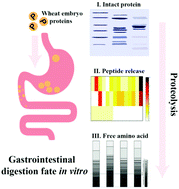Digestive characteristics and peptide release from wheat embryo proteins in vitro
Abstract
Due to the scarcity of the data on digestion and metabolism of wheat embryo proteins WEP, a simulated gastrointestinal digestion (SGID) scheme in vitro was utilized to explain the protein hydrolysis and biological activity of WEP during the digestion process. WEP had a certain degree of resistance to gastric digestion, especially the protein with a molecular weight of 50 kDa. In all the samples, no visually intact protein band emerged in sodium dodecyl sulfate-polyacrylamide gel electrophoresis (SDS-PAGE) during the intestinal phase, which was consistent with a gradually increasing content of released free amino acids. Moreover, the resistant digestion peptides (the amino acid sequences were ISQFXX and GTVX) were identified at the end of the gastrointestinal digestion (GID) product by high performance liquid chromatography-tandem mass spectrometry (HPLC-MS/MS). Although the complete protein in the sample was degraded, the antioxidant activity was not negatively affected, rather it showed an increasing trend and maintained a higher level of activity. The amount of the β-sheet gradually increased as that of the α-helix declined, the random coil decreased, whereas no obvious change was noticed in β-turn content. The results provide a better understanding for optimal selection of peptide candidates for designing protein products in the food processing industry as well as for WEP digestion and metabolism in the human body.



 Please wait while we load your content...
Please wait while we load your content...